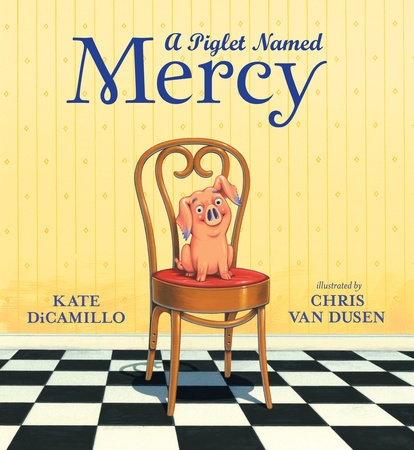There’s a New Piglet in Town:
Kate DiCamillo on Her New Book,
A Piglet Named Mercy
by Laura Lambert
Did you ever wonder how the porcine wonder, Mercy Watson, ended up with Mr. and Mrs. Watson? It’s a question any fan of the beloved Mercy Watson series for early readers might have asked. Now, they have an answer. With A Piglet Named Mercy, author Kate DiCamillo and illustrator Chris Van Dusen have rendered Mercy’s origin story in grand style, adding the first picture book to the existing Mercy Watson series — a porcine prequel, if you will.
Brightly caught up with DiCamillo to talk about the joy of writing Mercy and how the heroic, toast-loving pig’s origin story came to be.
A while back, I wrote a piece about “gateway” books — the book series that turned reluctant readers into lifetime readers — and Mercy Watson came up time and again. She really is a beloved character. Is that how A Piglet Named Mercy came about — people wanted more?
It was giving myself more, too. I woke up one morning and thought, “Wait a minute, that pig would have been a piglet.” It gave the 8-year-old in me such a joy to think about. And then Chris Van Dusen, the wonder of him. I thought, “Oh, Chris gets to turn the pig into a piglet!”
Has Mercy’s origin story been there the whole time?
No, never. You know, I did a couple of events locally for the book, and always — no matter if it’s all kids or kids and adults — there’s someone who asks for advice about writing. One of the first things I say is to carry a notebook with you. Then that notebook is there when things like “a pig, having once been a piglet” go through your head.
It was totally unanticipated. When I did the very first Mercy book, I knew there would be another one. I thought I’d do three of them. Then three became six. I could have kept going, but it seemed like it would have been forced. At that point, we went to the secondary characters. And then, the piglet showed up.
Did you always know she bounced off Molson’s Pig Transport?
That shows up in the first draft and stays in — happily. I will say that Molson’s will return . . .
So there’s more to the series?
Mercy is the only time I’ve thought in terms of series. They’re so much fun to do because you think of a situation and put Mercy in it, and she’s always irredeemably herself. When you write books for kids, people always ask, “What lesson did you mean to teach?” There’s really no lesson at all. She’s a pig.
What is it about Mercy do you think that speaks to a child — or the child’s parents, for that matter? I, for one, love her unabashed appetite. I love the spirit of unconditional love.
What I love is how they — all of them, with the exception of Eugenia — love Mercy unreservedly as herself. The whole book is pervaded with unconditional love. That makes me feel happy and safe as a writer, too.
When you write, do you have a specific child in mind?
It’s so funny that you ask that. In all these years, no one’s ever asked that. My best friend’s son is a grown-up now. You know when kids are two years old and they repeat things over and over? I was watching him. He had a little pig and a toy truck that he was pushing around. He would say “Ate” — because he couldn’t say Kate — “Ate! Look! Pig taking a ride.” Fifteen years later, you have Mercy Watson taking a ride. Luke is in there, with that obsession.
I’ve read that novels are really where your heart lies, but that often you’ll draft a complex novel and then go work on something a little smaller — like, I’m imagining, Mercy.
That’s another reason I love doing these books so much. I can’t cook at all, so this is a funny metaphor for me to use, but it’s like a piece of dough. As a manuscript, the Mercy books are about 18 pages; the Deckawoo books are about 30 pages. It’s nice because you can really work that piece of dough. It’s easy. A novel, it’s so unwieldy and difficult.
It must be like visiting Mercy after, say, a long, arduous journey.
I’ve said this before — another food allusion! — it’s like sorbet between the heavier courses. My heart is with those novels, and my heart is with Mercy, too. It’s just a lighter heart.
Is there anything else you want people to know about Mercy or the world of Deckawoo Drive?
I want people to know how grateful I am. When I did the first Mercy book, I gave it to my agent, and she said, “I don’t know what this is, but I really like it.” I had no idea what I was doing. It was just fun. And then she sent it to Candlewick, and they said, “We have no idea what this is, but we really like it.” And they figured it out. It was long for a beginning reader book when it first came out. And then librarians and booksellers and teachers put it into kids’ hands. A bookseller told me these are books that older siblings take to their younger siblings. I’m just so grateful for that.
A PIGLET NAMED MERCY. Text copyright © 2019 by Kate DiCamillo. Illustrations copyright © 2019 by Chris Van Dusen. Reproduced by permission of the publisher, Candlewick Press, Somerville, MA. This interview has been edited for length and clarity.

